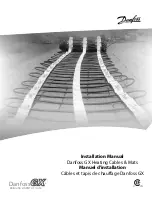
5
Multiple MF Arrivals
Multiple HF Arrivals Create
Too Much Low HF (1 – 2 kHz)
Array Performance Issues Addressed by Bandwidth
Too Much Low Mid (300 – 600 Hz)
Weak HF Response
L O W F R E Q U E N C Y L I N E A R R A Y S
The low frequency components within an individual KF750 array module behave as a tuned dipolar array, but in a
large format cluster the low frequency devices couple to behave as a line array (a column of closely spaced devices).
These LF line arrays provide tremendous output along the primary axis of a dead hung cluster, and their coverage
pattern mimics the contours of most venues. As a result, the LF subsection requires little adjustment except incre-
mental level attenuation as additional modules are employed.
M I D F R E Q U E N C Y L I N E S O U R C E S
The mid frequency horn in a KF700 Series module occupies the full frontal dimensions of the enclosure. As a result,
adjacent modules (including KF755’s) couple to behave as a true line source that exhibits increased directivity with
increased size, providing high levels of pattern control throughout the operating bandwidth. Projection of lower
mid frequency information is also improved to the point that low/mid energy in the long throw may need to be
attenuated to provide more spatial consistency.
The impulse response of a line source is most notably influenced by the edge events. That is, an impulse response
measurement reveals two distinct upper mid frequency arrivals coming from the physical edges of the line source
(i.e. the top of the top module and the bottom of the bottom module). Thus at an observation point beneath the
cluster the first measured arrival comes from the lower line source edge while the second, noticeably later, arrival
comes from the topmost edge. These multiple arrivals in turn produce comb filtering in the front rows of a typical
venue which, fortunately, can be eliminated with appropriate AS3D array shading .
H I G H F R E Q U E N C Y D I S T R I B U T E D S O U R C E S
The high frequency horns in a KF700 Series array are not prone to coupling as they are physically separated and
behave as distributed sources much like the behavior of KF850 arrays.
When using KF755’s as down/front fill loudspeakers, the mix position is typically provided with high frequency
output from the KF755’s as well as multiple rows of KF750’s. If the arrivals from the KF755's and the next row of
KF750’s are near one another in level, the bottom of the high frequency operating range becomes dominant at
front-of-house position. However, implementing appropriate AS3D array shading will eliminate this build up of
1kHz to 2kHz energy at FOH.
In long throw applications, the air's absorption of HF energy significantly impacts response as the distance from the
source increases. Techniques will be discussed later in this Guide that allow the user to address this specific issue.
Summary of Contents for KF750 Series
Page 2: ......








































